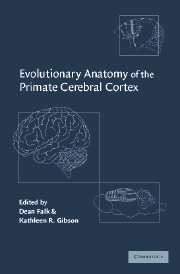Book contents
- Frontmatter
- Contents
- List of contributors
- Preface
- Prologue: Size matters and function counts
- Part I The evolution of brain size
- Part II Neurological substrates of species-specific adaptations
- Introduction to Part II
- 7 The discovery of cerebral diversity: an unwelcome scientific revolution
- 8 Pheromonal communication and socialization
- 9 Revisiting australopithecine visual striate cortex: newer data from chimpanzee and human brains suggest it could have been reduced during australopithecine times
- 10 Structural symmetries and asymmetries in human and chimpanzee brains
- 11 Language areas of the hominoid brain: a dynamic communicative shift on the upper east side planum
- 12 The promise and the peril in hominin brain evolution
- 13 Advances in the study of hominoid brain evolution: magnetic resonance imaging (MRI) and 3-D reconstruction
- 14 Exo-and endocranial morphometrics in mid-Pleistocene and modern humans
- Epilogue: The study of primate brain evolution: where do we go from here?
- Index
Introduction to Part II
Published online by Cambridge University Press: 07 October 2011
- Frontmatter
- Contents
- List of contributors
- Preface
- Prologue: Size matters and function counts
- Part I The evolution of brain size
- Part II Neurological substrates of species-specific adaptations
- Introduction to Part II
- 7 The discovery of cerebral diversity: an unwelcome scientific revolution
- 8 Pheromonal communication and socialization
- 9 Revisiting australopithecine visual striate cortex: newer data from chimpanzee and human brains suggest it could have been reduced during australopithecine times
- 10 Structural symmetries and asymmetries in human and chimpanzee brains
- 11 Language areas of the hominoid brain: a dynamic communicative shift on the upper east side planum
- 12 The promise and the peril in hominin brain evolution
- 13 Advances in the study of hominoid brain evolution: magnetic resonance imaging (MRI) and 3-D reconstruction
- 14 Exo-and endocranial morphometrics in mid-Pleistocene and modern humans
- Epilogue: The study of primate brain evolution: where do we go from here?
- Index
Summary
Despite the emphasis on brain size in the classic paleoneurological literature, it has long been recognized that species-specific adaptations have neurological substrates that depend on more than just overall brain size. This concept is embodied in Harry Jerison's principle of proper mass (1973, p. 8): ‘The mass of neural tissue controlling a particular function is appropriate to the amount of information processing involved in performing the function.’ Thus brains do not merely enlarge globally as they evolve, their cortical and internal organization also changes in a process known as reorganization. The chapters in Part II explore the neurological underpinnings of some of the senses, adaptations, and cognitive abilities that are important for primates.
It is fitting that this section opens with a chapter on cerebral diversity by Todd Preuss that provides a clear synopsis of mammalian cortical anatomy, thus laying the groundwork for the rest of the volume. Preuss details the tension between classical studies that emphasize the microanatomical similarities between brains of different mammals and therefore highlight brain size as a main focus of natural selection, and more recent investigations that reveal a remarkable diversity in mammalian cortical organization and therefore emphasize neurological reorganization as a driving force during brain evolution (Preuss, 1993, 1995). There is no doubt where Preuss comes down in this debate, as is clear from his observation that ‘to focus exclusively on the ancestral features of cortical organization that mammals share, however, is to ignore those features of cortical organization that distinguish one group of mammals from another and provide the basis for their particular behavioral and cognitive abilities.’
- Type
- Chapter
- Information
- Evolutionary Anatomy of the Primate Cerebral Cortex , pp. 131 - 137Publisher: Cambridge University PressPrint publication year: 2001

